Overview
This article examines ten pivotal trends in office real estate that are defining the future of work. Notable among these are:
- The emergence of hybrid work models
- A commitment to sustainability
- The increasing demand for flexible office spaces
These trends are reshaping workspace design and utilization, highlighting the critical need for adaptability and innovative solutions. As the workforce evolves, so too must our approaches to office environments, ensuring that productivity is not just maintained but enhanced. Understanding these dynamics is essential for making informed investment decisions in the real estate sector.
Introduction
The landscape of office real estate is undergoing a seismic shift, driven by evolving work models, sustainability imperatives, and the relentless pace of urbanization. As organizations grapple with the implications of hybrid work arrangements and the demand for flexible spaces, understanding these trends becomes essential for real estate professionals and investors alike.
What strategies can businesses adopt to navigate this dynamic environment and ensure their office spaces meet the needs of a modern workforce? This article delves into ten key trends shaping the future of work, offering insights that could redefine how spaces are utilized and valued in the years to come.
Zero Flux: Daily Insights on Office Real Estate Trends
Zero Flux delivers critical insights into office real estate trends by aggregating data from over 100 credible sources. This daily newsletter empowers subscribers with the latest developments, enabling them to stay ahead in the rapidly evolving workplace environment. With a strong emphasis on factual data, Zero Flux assists real estate professionals and investors in effectively navigating market complexities. Notably, the U.S. vacancy rate for commercial properties reached 19.4% in June 2025, reflecting ongoing shifts in utilization as companies adapt to hybrid employment models. This figure marks an increase compared to previous years, suggesting a significant transformation in the use of work environments.
Moreover, the newsletter's subscriber base has expanded considerably, with over 30,000 individuals relying on its data-driven approach to comprehend the key trends shaping the future of work. As the workplace market shows signs of improvement and demand stabilizes, with major corporations reassessing their workspace strategies, Zero Flux remains an indispensable resource for those seeking to understand the office real estate trends. Investors are urged to focus on high-end work environments in prime locations, as the current 'flight to quality' trend suggests that well-positioned assets will continue to attract interest.

Hybrid Work Models: Redefining Office Space Utilization
The emergence of hybrid employment models is fundamentally transforming space utilization, prompting companies to adapt to office real estate trends by adopting flexible arrangements that combine remote and in-person tasks. By 2025, approximately 60% of enterprises are anticipated to adopt a hybrid employment model, prompting a comprehensive reevaluation of office real estate trends and workspace configurations. Organizations are striving to cultivate environments that encourage collaboration while also supporting remote activities. As a result, workspace designs increasingly incorporate shared workstations and collaborative zones, catering to the diverse needs of the modern workforce.
However, 85% of employers indicate that a majority of their office areas are allocated to personal working zones, emphasizing the persistent challenge of balancing individual and collaborative environments in hybrid employment settings. Workplace planners stress that establishing a balance between individual areas and shared spaces is crucial for boosting staff engagement and productivity. As Miro Miroslavov, CEO and Co-founder of OfficeRnD, states, "Hybrid arrangements don’t occur by chance; you need to be intentional, proactive, and thoughtful to ensure it operates effectively."
As organizations navigate this transition, the emphasis on adaptable workspace designs will be vital in addressing the changing needs of staff and aligning with office real estate trends to promote a culture of teamwork. Furthermore, it is crucial to acknowledge that 42% of staff believe their workspace is well-prepared for hybrid arrangements. Yet, the merging of lines between professional and personal life can result in burnout, as pointed out by Miroslavov. Overall, the hybrid work model not only enhances employee happiness—remote and hybrid employees are 22% happier and tend to stay longer in their jobs than those in all-office settings—but also requires careful planning to mitigate potential risks.

Sustainability Focus: Integrating ESG in Office Developments
Sustainability is emerging as a central theme in commercial real estate development, driven by the integration of Environmental, Social, and Governance (ESG) principles. Developers are increasingly focused on constructing energy-efficient buildings that utilize sustainable materials and incorporate advanced green technologies. This transition not only fulfills regulatory requirements but also attracts environmentally conscious tenants and investors. As organizations emphasize sustainability, work environments that reflect these values are anticipated to see increased demand and occupancy rates.
Notably, the U.S. is leading the way with over 511 million square feet of LEED-certified construction projects underway, reflecting a significant commitment to sustainable building practices, supported by an investment of $86 billion in green building projects in 2021. Furthermore, properties with green certifications, such as LEED, often command higher valuations and rental premiums.
- LEED-certified buildings achieve 31% higher average rents than their non-certified counterparts.
- This underscores the financial advantages of investing in sustainable workspaces, especially considering that structures and their energy consumption account for 40% of global carbon emissions.
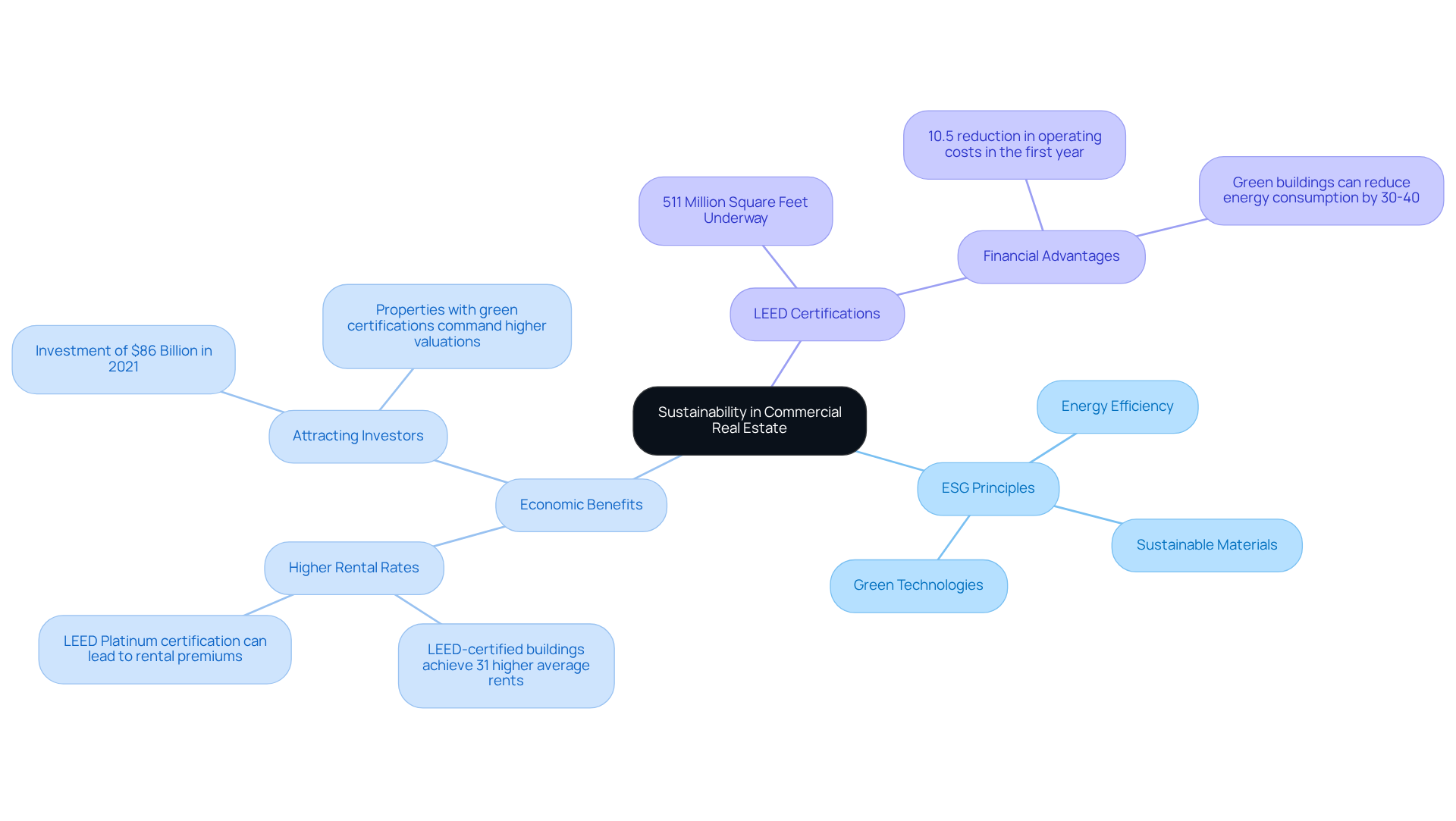
Flexible Office Spaces: Catering to Dynamic Workforce Needs
Adaptable work environments are increasingly preferred by organizations aiming to meet the dynamic needs of their workforce. These flexible settings offer a range of arrangements—from private workspaces to collaborative open-plan areas—enabling businesses to scale operations efficiently. This adaptability not only boosts employee satisfaction—evidenced by 81% of individuals in flexible arrangements reporting improved work-life balance—but also allows 69% of users in shared environments to acquire new skills, highlighting the broader benefits of flexible employment settings.
As businesses embrace hybrid employment models, the demand for adaptable workplace solutions is projected to surge significantly, in line with current office real estate trends. Notably, coworking inventory is expected to grow by 13% year-over-year in terms of square footage by Q3 2024, while the total number of coworking spaces in the U.S. has expanded by 22% during the same period. This trend underscores the necessity for organizations to invest in flexible workspace designs that respond to office real estate trends, fostering collaboration and enhancing overall workplace satisfaction.
Moreover, companies stand to save approximately $11,000 per employee annually by adopting flexible work options. This financial incentive reinforces the strategic advantages of these innovative spaces, making a compelling case for investment in adaptable work environments.
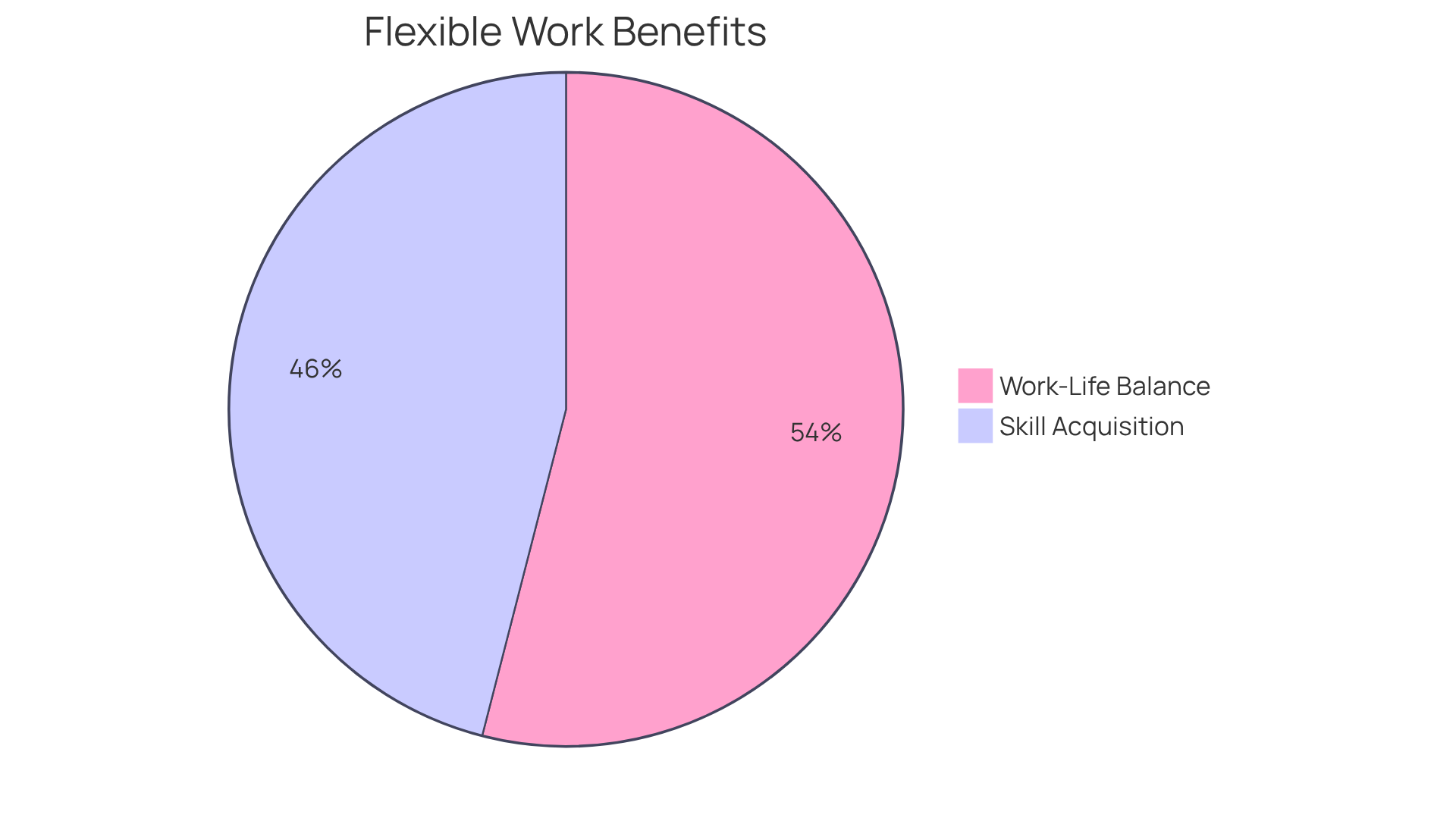
Tech Integration: Enhancing Office Functionality and Experience
The incorporation of intelligent building technologies is fundamentally transforming office environments, reshaping how individuals interact with their workspace and reflecting the latest office real estate trends. Innovations such as Internet of Things (IoT) devices and automated systems not only optimize energy consumption but also bolster security measures, creating safer and more efficient workplaces. For instance, companies that have implemented smart technologies report a significant reduction in operational costs and improved employee satisfaction, with 75% of companies noting a competitive advantage from using workflow automation.
Additionally, sophisticated communication tools enable effortless remote collaboration, particularly as 85% of environments are adopting hybrid arrangements, allowing teams to sustain productivity irrespective of their physical location. As the workforce becomes increasingly tech-savvy, the office real estate trends show a growing demand for modern facilities in offices. Organizations that adopt these innovations are better positioned to attract and retain top talent, ensuring a competitive edge in the context of office real estate trends.
As noted by Sean Gerety, "The technology you use impresses no one. The experience you create with it is everything," emphasizing the importance of creating experiences that enhance productivity and well-being, rather than merely integrating technology for its own sake.

Co-Working Spaces: Fostering Collaboration and Flexibility
Co-working venues are increasingly recognized for their ability to create flexible environments that enhance collaboration among diverse professionals. These spaces typically feature communal facilities, meeting rooms, and abundant networking opportunities, making them appealing to freelancers, startups, and established companies alike. With 72% of employees expressing a preference for flexible work arrangements, co-working environments meet the evolving demands of today’s workforce by fostering a sense of community and adaptability.
The communal atmosphere of co-working spaces not only facilitates networking but also boosts collaboration across various sectors. Notably, 80% of co-working members report that these shared workspaces have broadened their professional networks, underscoring the importance of interaction in fostering innovation and creativity. Furthermore, the rise of hybrid work models—where 71% of the U.S. labor force engages in remote or hybrid setups—emphasizes the necessity for adaptable solutions that co-working spaces provide.
Experts anticipate that the co-working market will continue to flourish, propelled by the growing number of startups and the demand for flexible workspaces. The global co-working market is projected to expand from $8 billion in 2021 to $30 billion by 2030, with a revenue forecast of USD 36.92 billion by that year. As businesses aim to optimize operational costs—potentially saving 25-30% by utilizing co-working spaces instead of traditional offices—the advantages extend beyond individual professionals, benefiting entire organizations. By embracing co-working environments, companies can enhance employee satisfaction, improve collaboration, and ultimately drive productivity in an ever-evolving work landscape.
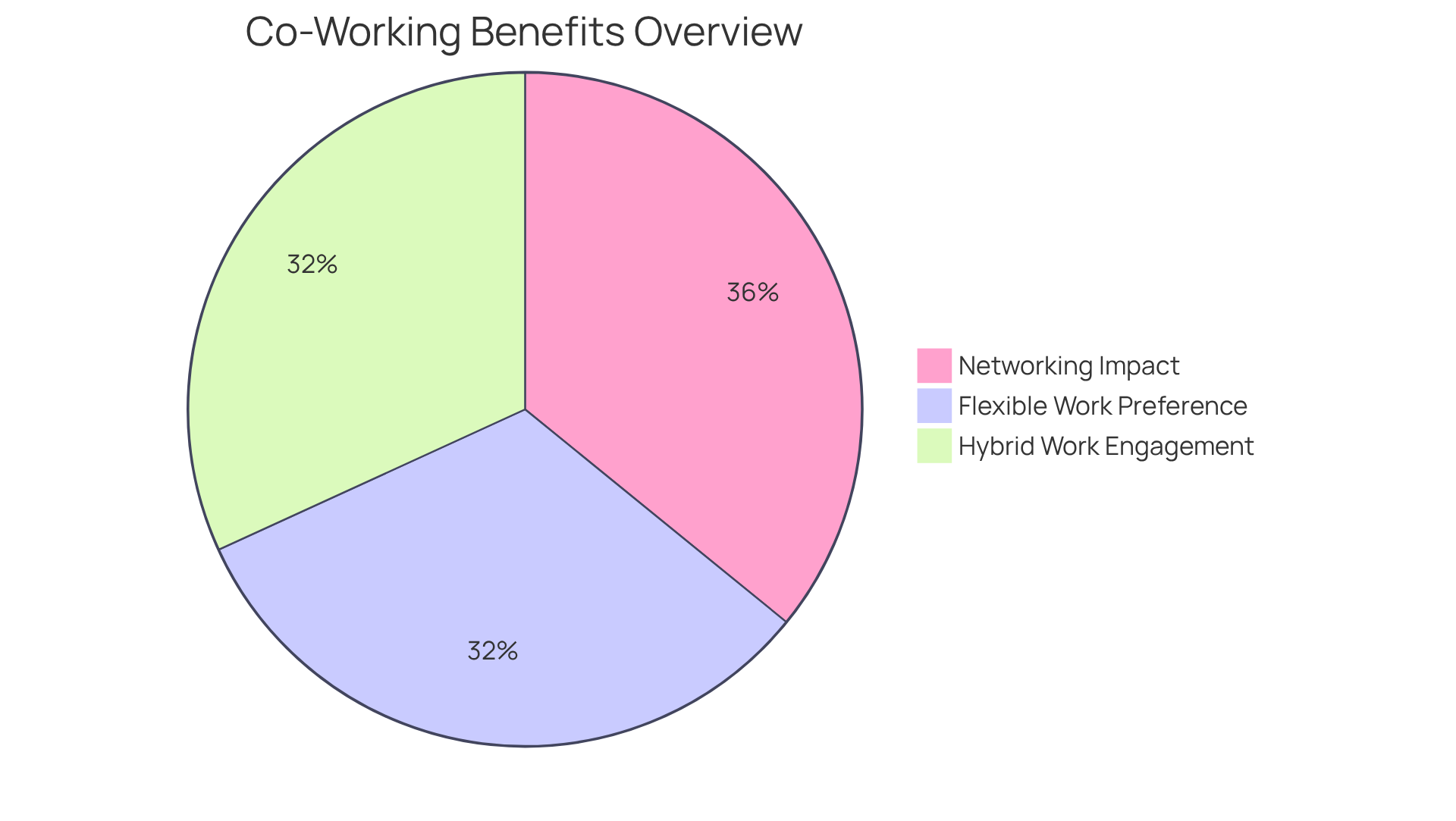
Health and Wellness: Prioritizing Employee Well-Being in Office Design
Health and wellness have emerged as pivotal components in modern office design, compelling companies to invest in features that enhance employee well-being. Maximizing natural light, integrating biophilic design, and providing wellness amenities—such as fitness centers and relaxation areas—are key elements in this transformation. Research indicates that environments prioritizing health can significantly boost employee satisfaction and productivity; for instance, studies reveal that investing in workforce wellness can lead to a 20% increase in productivity and a 30% reduction in turnover rates. Organizations that adopt wellness-focused designs report heightened morale and engagement, underscoring that such investments are not mere perks but strategic imperatives.
Successful projects frequently incorporate:
- Ergonomic furniture
- Air-purifying plants
- Designated quiet zones
Case studies like 'Prioritizing Air Quality' and 'Designing for Ergonomics' illustrate the positive effects of these features on employee well-being. As Richard Branson aptly noted, caring for staff translates to improved business outcomes, reinforcing the notion that a commitment to employee wellness is crucial for thriving organizations. Furthermore, integrating elements like color psychology can enhance workplace environments; warmer colors, for example, can stimulate creativity and focus, thereby contributing to overall productivity.
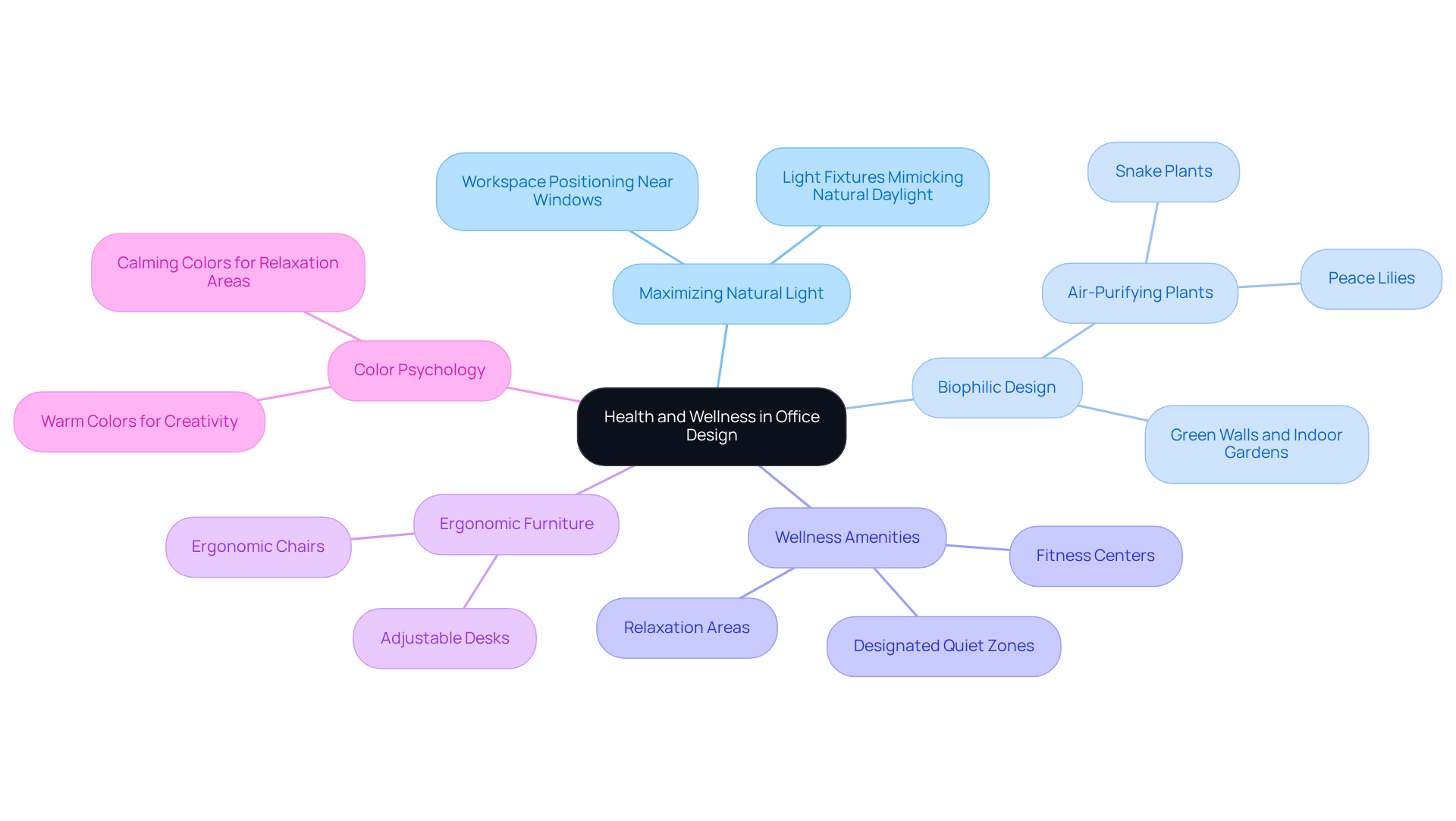
Remote Work Impact: Reevaluating Office Space Needs
The rise of remote work has fundamentally transformed how organizations assess their workplace needs. With a growing number of employees working remotely, many companies are opting to reduce their physical office spaces or adapt existing areas to better accommodate a hybrid workforce. This trend is underscored by the fact that:
- 44% of companies still require all employees to be on-site
- Hybrid job postings have surged from 9% in Q1 2023 to 24% in Q1 2025
- 61.9% of companies are planning to implement more remote arrangements due to COVID-19
This indicates a lasting shift towards flexible employment models. Notably, 83% of workers globally assert that hybrid arrangements are ideal, highlighting the demand for adaptable work environments.
To navigate this shift effectively, businesses must adopt strategic approaches to workspace leasing and design. Successful workspace redesigns focus on creating adaptable environments that foster collaboration while optimizing costs. For instance, collaborative areas are now utilized 64% more than traditional desks, emphasizing the necessity for flexible workspaces that support both individual and group activities.
As organizations scale back their physical work environments, they are also reevaluating their design strategies. This includes the integration of advanced technology to facilitate seamless communication and collaboration among remote and in-office employees. The emphasis on blended employment models is reshaping the commercial real estate landscape, with experts predicting that office real estate trends could lead to vacancy rates for commercial spaces reaching 19% by the end of 2025, and the national vacancy rate for commercial properties may hit a record high of 20.1%.
In this evolving market, organizations that proactively adapt to these changes can uncover new opportunities, particularly in suburban areas where office real estate trends indicate an increasing demand for quality office spaces. By prioritizing significant work environments and embracing the flexibility that remote arrangements offer, companies can enhance employee satisfaction and productivity while effectively managing their real estate investments. As Richard Branson aptly stated, "Great leaders understand that in remote environments, it’s not about micromanaging hours but empowering results."
To apply these insights, companies should consider conducting regular evaluations of their workspace requirements and employee preferences to cultivate a more efficient and engaging work environment.
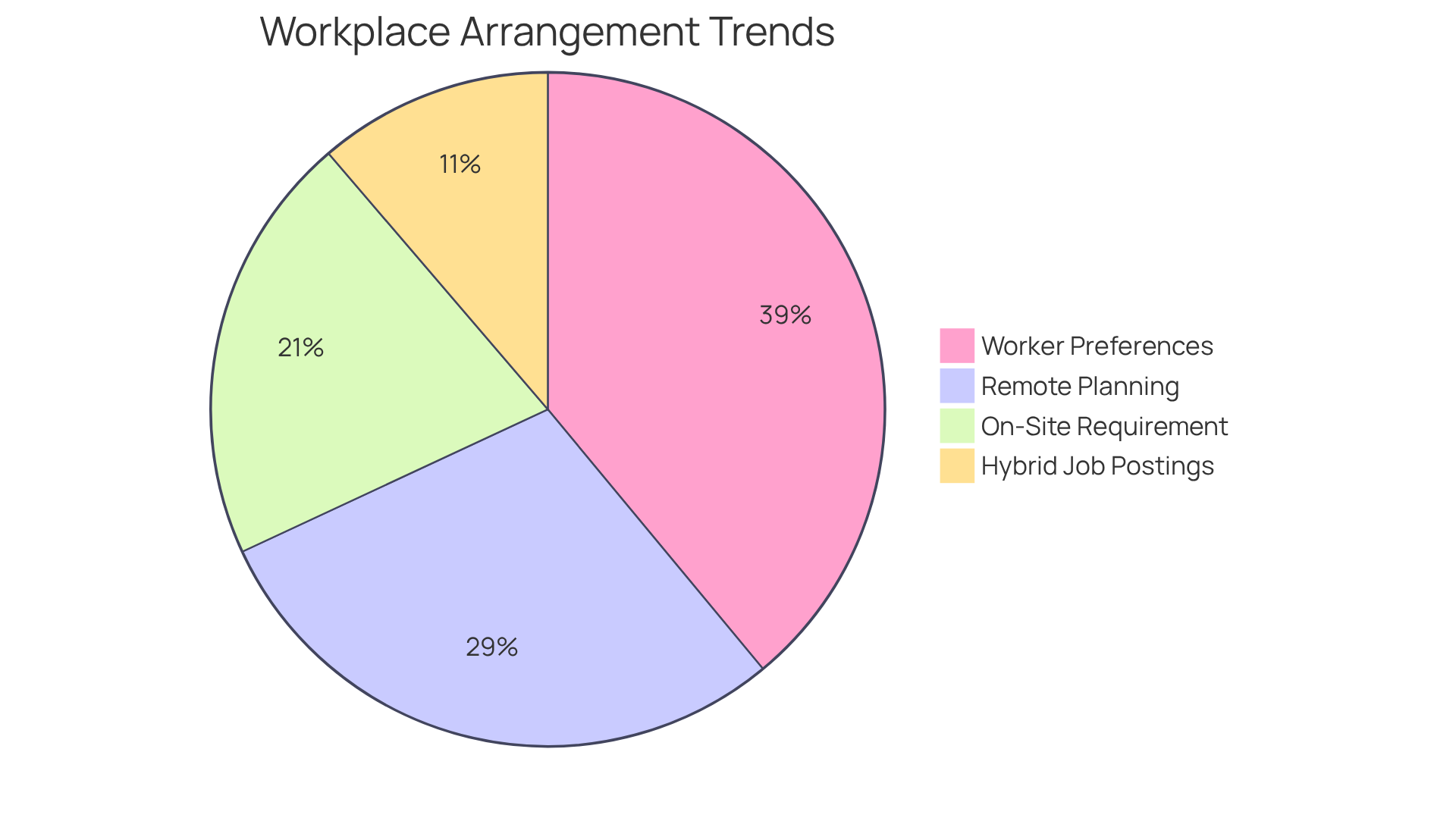
Urbanization Trends: Shaping Office Location Strategies
Urbanization trends are profoundly influencing office real estate trends and workplace location strategies. As more individuals migrate to urban centers in search of job opportunities and enhanced amenities, real estate developers are prioritizing urban locations that reflect the current office real estate trends, providing accessibility and convenience for employees. These factors significantly enhance the attractiveness of workspaces, in line with office real estate trends that cater to the preferences of a modern workforce valuing proximity to urban amenities and efficient public transportation options.
Statistics reveal that over 4 billion people currently reside in cities, with urban populations projected to double by 2050. This underscores the urgency for developers to adapt to the changing office real estate trends. Cities are recognized as engines of economic development, producing approximately 80% of global GDP and 88% of private sector employment growth. Thus, the office real estate trends in urban projects are not merely a strategic option; they are a necessity for future success.
As the World Bank states, 'Cities are engines of economic growth and development,' emphasizing the critical role urban environments play in fostering economic opportunities. However, the challenges posed by the 'new urban crisis' necessitate a thoughtful strategy that considers office real estate trends in urban planning. It is essential that commercial developments address the evolving demands of the workforce while considering the complexities of urbanization and the current office real estate trends.
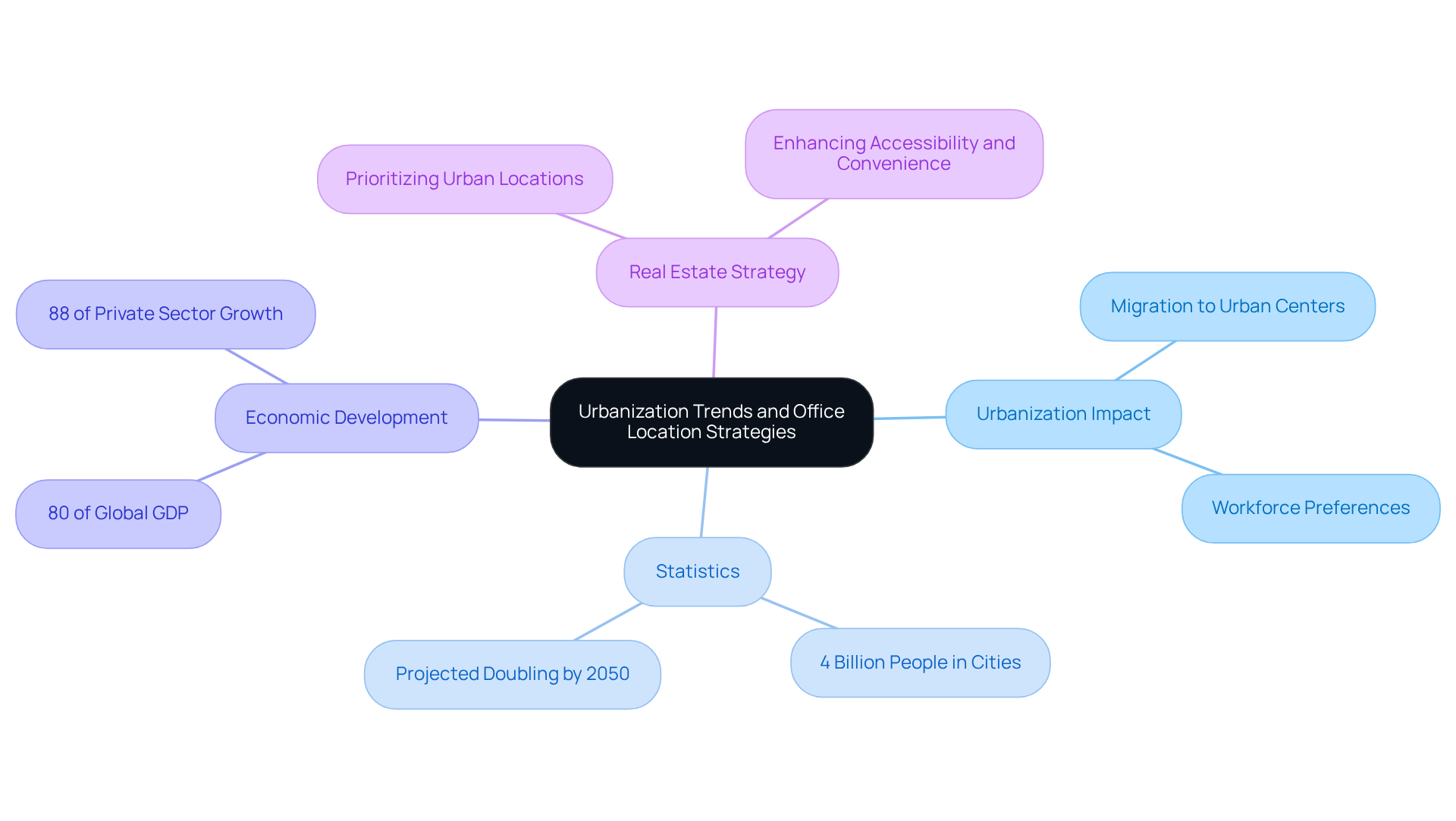
Leasing Evolution: Adapting to New Office Market Dynamics
The commercial leasing landscape is undergoing a significant transformation as landlords and tenants adapt to office real estate trends and changing market dynamics. Flexible lease conditions and shorter commitments are increasingly favored, with 49% of respondents considering or implementing these options for new or renewed locations. This trend aligns with a broader movement of companies aiming to mitigate risks amid economic uncertainty, which is reflected in office real estate trends, as evidenced by 58% of large occupiers contemplating transitions to higher-quality work environments. Additionally, co-working arrangements are gaining traction, reflecting a widespread desire for adaptability in a rapidly evolving landscape.
Real estate economists observe that the resurgence of return-to-office mandates from major employers is fueling leasing momentum, particularly in urban cores, which highlights the latest office real estate trends. Leasing activity in prime commercial buildings is expected to rise later in 2024 and into 2025, as more tenants seek accommodations in major markets, anticipating lower interest rates and enhanced clarity regarding utilization.
Statistics indicate that leases sized between 10,000 and 20,000 square feet account for 54% of all lease transactions over the past five years, underscoring a preference for flexible arrangements that cater to diverse business needs. As companies navigate these challenges, the emphasis on quality and sustainability in office real estate trends is becoming increasingly paramount. Notably, 55% of respondents consider a building's green certification when making real estate decisions. This evolution in leasing practices not only enables landlords and tenants to address current challenges but also positions them to seize emerging opportunities within the office market.

Conclusion
The landscape of office real estate is undergoing a profound transformation, driven by emerging trends that reflect the evolving needs of the workforce and the demands of modern businesses. The shift towards hybrid work models, sustainability, flexible office spaces, and technological integration are not merely trends; they signify a fundamental rethinking of how work environments are designed and utilized. As organizations adapt to these changes, they must prioritize creating spaces that foster collaboration, support individual productivity, and promote overall employee well-being.
Key insights from the article highlight the importance of integrating Environmental, Social, and Governance (ESG) principles into office developments, the rising demand for adaptable workspaces, and the growing significance of health and wellness in design. Data underscores that companies prioritizing these factors can enhance employee satisfaction, reduce turnover, and ultimately drive productivity. Moreover, the evolution of leasing practices towards more flexible arrangements reflects a broader trend of businesses seeking to mitigate risks while maintaining agility in their operations.
In summary, the future of office real estate transcends physical spaces; it centers on creating environments that adapt to the needs of a dynamic workforce. As urbanization continues to shape location strategies and organizations embrace new technologies, the focus must remain on fostering innovative, sustainable, and collaborative workplaces. Companies are encouraged to stay informed and proactive in their approach to these trends, ensuring they remain competitive in an ever-evolving market. Embracing these insights can lead to smarter investments and a more engaged workforce, ultimately shaping a brighter future for workspaces everywhere.




